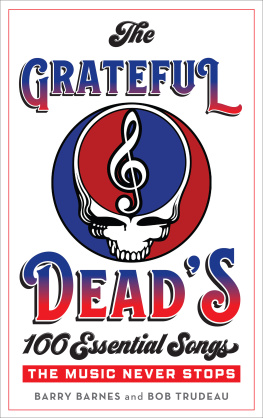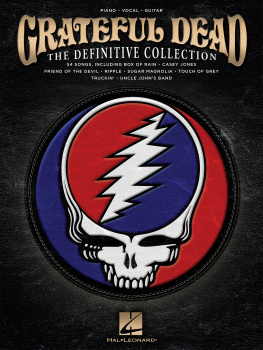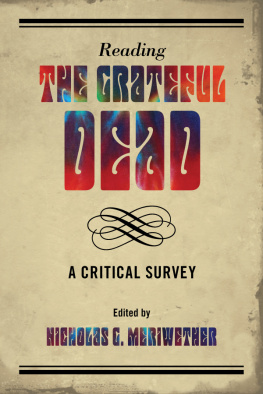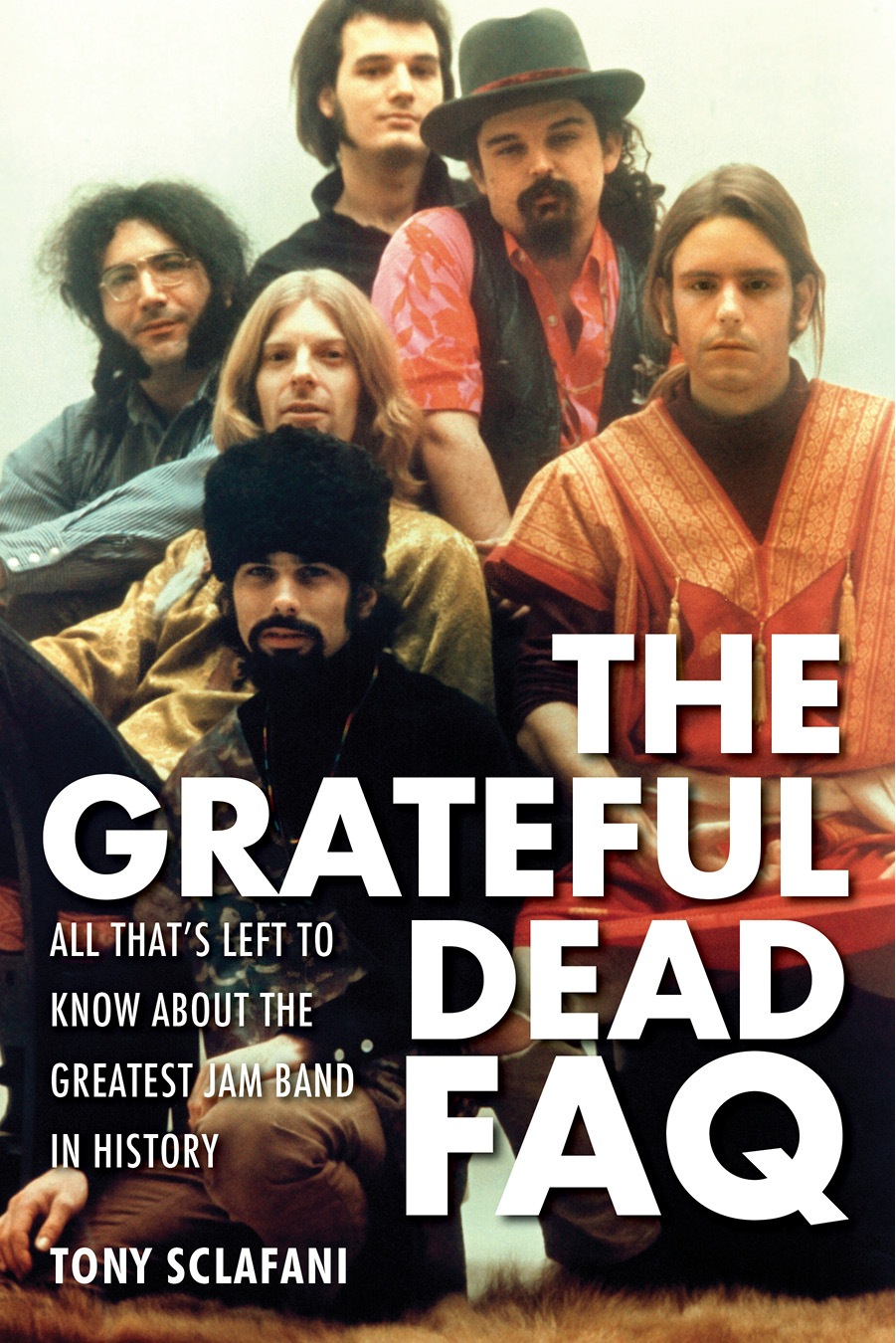Copyright 2013 by Tony Sclafani
All rights reserved. No part of this book may be reproduced in any form, without written permission, except by a newspaper or magazine reviewer who wishes to quote brief passages in connection with a review.
Published in 2013 by Backbeat Books
An Imprint of Hal Leonard Corporation
7777 West Bluemound Road
Milwaukee, WI 53213
Trade Book Division Editorial Offices
33 Plymouth St., Montclair, NJ 07042
The FAQ series was conceived by Robert Rodriguez and developed with Stuart Shea.
Book design by Snow Creative Services
Printed in the United States of America
Library of Congress Cataloging-in-Publication Data is available upon request.
www.backbeatbooks.com
To Sharon, for answering the musical question
How does the song go?
Contents
I first became aware of the Grateful Dead in 1966. I was about eleven years old. I grew up in San Francisco in the heyday of the Haight-Ashbury renaissance. I loved the Dead, but I also loved Quicksilver Messenger Service, Jefferson Airplane, the Sons of Champlin, Moby Grapeall those bands. The Dead were definitely a huge influence on my friends and me, but there werent even any Deadheads back then. Nobody followed the band on tour. All that came much later.
In spring of 1998, when I got the call to try out for the Other Ones, the Grateful Dead had become not much more to me than a warm, fuzzy touchstone of my youth and early musical influences. I was (and still am) pretty fond of Live/Dead and the album many lovingly refer to as Skullfuck , as well as Europe 72 , Workingmans Dead , American Beauty , and Wake of the Flood . Those records were all in my collection, and I listened to them over the years and loved them, but I hadnt played that music myself in a very long time.
The truth is, I was surprised when I ended up getting the gig. I previously hadnt had much success at auditions. Id get nervous, try too hard, and freeze up. When I went to the Other Ones audition, I assumed I wasnt going to get the gig and just thought, Wow, how awesome... I get to play with the guys I grew up watching and listening to as a kid. I had a really fun time, and I think thats why they liked me. It was pretty amazing.
Getting to tour with the boys was fun, rewarding, surreal, and incredibly confusing all at the same time. They ended up taking both Steve Kimock and me as twin lead guitar players. The thing was, in classic Grateful Dead fashion, we never worked out any details about who would do what, or when. Plenty of times, Steve and I would just look at each other when it came time to play the lead guitar parts and say, I dont knowyou wanna go or should I?
It was humbling to become part of the music that had been so much of an influence on my early history. I think the biggest gift I got from playing with the Other Ones (and with Bob Weir and RatDog) was rediscovering a very real sense of musical freedom and rediscovering my passion for music for the sake of the music, not for commercial success. Coming back into the family was an opportunity to reconnect with what drew me to music in the first place.
I think theres sort of an idealized vision of who the Grateful Dead are and what they represent from the fan perspective, but to me theyre just humans like any others. I know them now as friendspeople Ive actively collaborated with. But Im also very aware that they were responsible for the development of an entire approach to musicwhats become known as the jam band. I believe that the Dead originated the whole idea of doing things differently and giving rock n roll as much room to improvise and express itself as jazz had traditionally gotten. Of course, a lot of jam bands dont seem very musically influenced by the Dead, yet conceptually, their roots are there. I think the Dead will always be seen as a huge source of inspiration and innovation in the history of rock n roll music.
There are now huge numbers of people worldwide who fit the term Deadhead. Part of that group is, of course, the hippie community, but many modern Deadheads are now stockbrokers, insurance salesmen, and the like. Its like the bumper sticker says: Weir Everywhere. Sociologically, this entire segment of the population are bound together by their common love of the music of the Grateful Dead and the particular sort of social ethics and sense of community that has been created as an extension of that love. I cant think of too many bands that have had such a far-reaching impact. Maybe the Beatles.
Mark Karan
2013
Mark Karan has played guitar and sung for artists ranging from Dave Mason to Delaney Bramlett to Huey Lewis. In 1998, he was picked (along with Steve Kimock) to play lead guitar in the Other Ones, a group made up of all the former members of the Grateful Dead, along with Bruce Hornsby on piano and Dave Ellis on saxophone. He has also been the lead guitarist of Bob Weirs RatDog since 1998 and has performed with Mickey Harts Planet Drum and Phil Lesh and Friends. A cancer survivor, he released his first solo album, Walk Through the Fire , in 2009.
Even though this book bears the name of one author, a lot of people influenced the writing of it. Id like to extend special thanks to the following people:
Sharon Balan, for being a collaborator, editor, proofreader, sounding board, and so much more.
Toni Brown, David Gans, Mark Karan, Carol Latvala, Dennis McNally, and David Lemieux, who took the time to explain a lot of details.
Arion Berger, my former editor at the Washington Post Express ; Denise Hazlick, editor at NBC.com; and Peter Lindblad, the former editor of Goldmine , for assigning Dead-related articles that led to the writing of this book.
Stuart Dahne, Rich McManus, and Eric Schwartz, for the scans of tickets and picture sleeves.
Josh Baron, for tons of Relix covers.
Traci Balter Tyo, for creating a Facebook post that led to a chapter.
Jean Pfefferkorn at the Howard County Public Library, for background information and explaining how those strange, old microfilm machines work.
Rob Bleetstein, Annemarie Hunt Dauer, Kathi Abernethy Dunsmore, Dean Grabski, Emily Vitullo Martin, Cathy Garland Meyers, Sue Smith, and John Sybert, for the quotes and stories.
Gary Gebler of Trax on Wax Records, for vinyl discoveries.
Barbara Kellner of the Columbia Archives, for old news clippings, info, and support.
Steve Sclafani and Dave Lax of the Baseball Factory, for help with scans.
David Vitagliano, for being the first to encourage me to pursue writing and for bringing up Dark Star during tenth grade journalism class.
Thanks also to Cary Baker, Warren Belasco, Mike Duffy, Todd Everett, Russ Grabski, Karl Groeger, Skip Groff, Richie Latvala, Carrie Lombardi, John Lynskey, Ellie MacKnight, Bernadette Malavarca, Rosie McGee, Nicholas Meriwether, Chris Mosher, Allon Porter, Robert Rodriguez, Audrey Fix Schaefer, Susan Sliwicki, Michael Valentine Smith, Jon Stebbins, Liz Stewart, Jason Thrasher, Alan Trist, and Bob Weir. And thanks to Backbeat Books and the Hal Leonard Group for allowing me to indulge professionally in the type of thinking and topics that earned me disapproval from guidance counselors and other figures of authoritah.
Box of Rain
I first connected with the music of the Grateful Dead in the pouring rain, during a frighteningly loud thunderstorm. When I was at work.
It was a dark, dreary Monday nightJune 20, 1983and I was a teenager working a summer job as a parking lot attendant at Merriweather Post Pavilion in Columbia, Maryland. The Grateful Dead were playing a two-night stand, and no one seemed happy about having to direct traffic with sheets of rain crashing down. The storm grew worse and chaos started to reignpun intendedso a bunch of us ran from the parking lot into the concert park, where we took cover under an awning and attempted to dry off. (Confession: we snuck in past the distracted security guards. Hope I dont get retroactively fired for this.)








